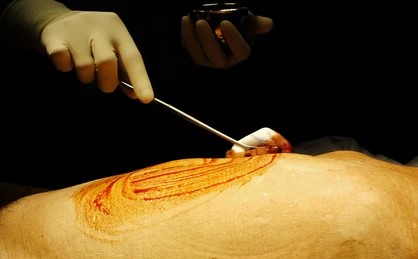Skin Cleaning and Draping
Skin Cleaning and Draping
SHAVING
§ The
operation area should be clean (no infection) before the operation.
§ The
area of operation should be shaved on the morning of the operation or in the
O.T at the time of operation.
Skin Cleaning:
§ Prepare
the skin as soon as the patient is anaesthetised, to reduce the risk of
infection.
§ Start
cleaning with a soap solution/ povidone (it is 2% iodine) and follow this with
spirit.
§ Take a
sterile swab/sponge in a holder, start in the middle of the operation site, and
then works outwards (centrifugally).
§ Discard
both swab/sponge and holder, and repeat the process with a second swab on a new
holder.
§ The spirit will evaporate to leave the skin dry.
§ Be sure to prepare a wide area of skin.
§ In abdomen operation, it should extend from the patients’
nipple line to below his groin.
Aim of Skin Cleaning:
The aim of skin cleaning is to remove contamination (e.g.: blood, body fluids, dust).DRAPING
Once the skin has been prepared/cleaned ----then start
Draping:
§ Place the first towel across the lower part of the operation.
§Place
another towel at the right angle on the near edge of the operation site.
§ Apply a
towel clip at the point of crossing of the two towels.
§ Place
another towel at far edge of the operation site.
§ The final towel goes across the top end of the site. All the corners should have towel clips to prevent the towels from slipping; they can go thru the skin if the operation is under G.A.
§ In an abdominal operation, an abdominal sheet covers the abdomen on the top of the towels. This sheet has opening in its middle to provide access to the operation site (double toweling).
§ If any area close to the operation site becomes contaminated at any time during the operation, place another sterile towel over the contamination site.
§ (Draping is done with towels made up of non-porous, non wet-able, synthetic, transparent material/sheets. Drapes should be resistant to blood or liquid penetration).
Purpose:
§ The purpose of draping is to establish a sterile field around the operative site, thus preventing the passage of bacteria b/w non sterile and sterile areas. The incision area is the only area exposed. Sterile drapes cover all unprepared areas of the patient.
§ Drapes form a complete seal over the skin, thus protecting the wound from bacteria and excretions.
Advantage:




Comments
Post a Comment